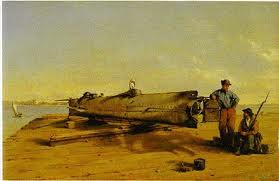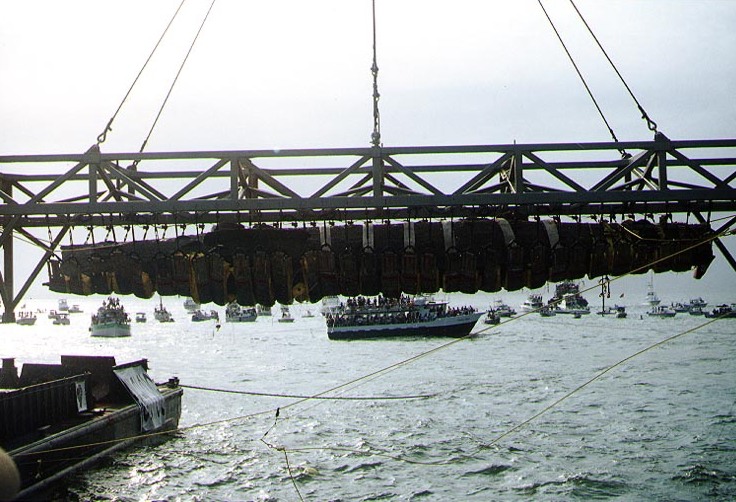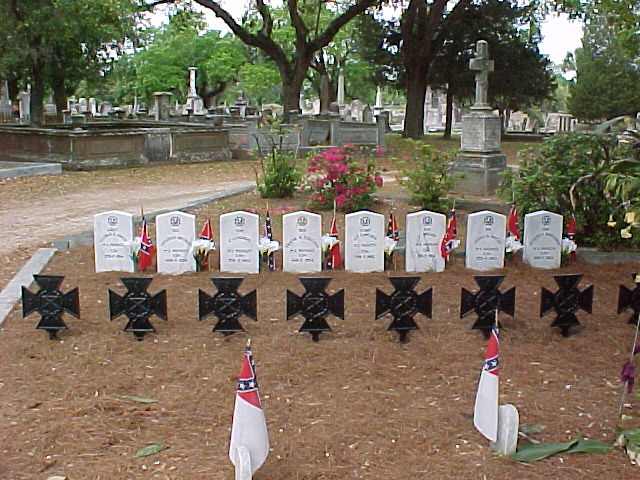Making Naval History: The CSS Hunley

Originally christened as Fish Boat and constructed in Mobile, Alabama, the Confederate submarine H. L. Hunley was plagued with bad luck. The Hunley was first launched in July 1863 and sank during a training exercise just 17 days after reaching the Confederate port in Charleston, South Carolina. Five crewmembers were killed. The Hunley was repaired and sent back into action. This time the crew included her namesake and inventor Horace Lawson Hunley. She sank again on October 15, 1863, taking all crewmembers with her to meet Davy Jones. The Hunley was then repaired and launched yet again. Third time’s a charm: on this voyage she would make naval history.
The submarine was originally designed to attack by means of a floating explosive charge. She would dive beneath an enemy ship while dragging a torpedo – this would allow her to resurface at a safe distance by the time the enemy’s ship exploded. But this design was not without danger to the sub and her crew. There was a chance that the torpedo could drift right into the side of the submarine. Experts saw this risk and changed the defensive design of the Hunley before she was launched. They decided to equip her with a spar torpedo. Attached to a 22-foot-long spar, the torpedo was used to ram enemy ships. In theory, the weapon was stabbed into the enemy vessel. While the submarine safely backed away, a mechanical trigger attached via cord to the Hunley would activate the explosion.
Before the Hunley set out on her last and only mission during the Civil War, she underwent more remodeling. After Horace Hunley’s untimely death, General Beauregard issued an order that prohibited the vessel from attacking while underwater. The Hunley was then modified to resemble an earlier vessel, the CSS David. A downward-angled iron pipe was attached to the sub’s bow, which enabled the Hunley to deliver an explosive charge while floating at the water’s surface.
On February 17th, 1864 – 150 years ago this month – the CSS Hunley made its way out of the Charleston Harbor in South Carolina. As part of the Union naval blockade, the USS Housatonic was stationed at the entrance to the harbor. The 1,240-ton Housatonic was equipped with 12 cannons. The Hunley planned to attack the Housatonic in an effort to lift

the blockade. Manned by Confederate Lieutenant George E. Dixion and a group of seven volunteers, the submarine crept towards the Housatonic. Reports differ, but it is clear that the sub remained invisible to the enemy until the last possible moment. The Hunley successfully embedded and detonated its spar torpedo. Within five minutes most of the Housatonic was below water, making the Hunley the first submarine in naval history to successfully attack and sink an enemy vessel.
The sinking of the Housatonic guaranteed the Hunley a spot in naval history. However, despite the Hunley’s success, not a soul would see the sub for over 100 years. As she made her way back home to the port at Sullivan Island, the Hunley sank for the third time. Did she sustain damage in her fight against the Housatonic? Many reports claim that the Hunley remained afloat for at least an hour after the attack. So why did she sink? The commander at Fort Moultrie reported signals from the Hunley observed and answered and a lookout on the Housatonic reported signal lights. The cause of the Hunley’s demise was a mystery. In January 2013, conservator Paul Mardikian announced that he had found evidence of a copper sleeve on the end of the Hunley’s spar, indicating that the torpedo and spar may have been directly attached. According to this data, it is entirely possible that the submarine was less than 20 feet away when the torpedo exploded. In this situation, damage to the Hunley and her crew is likely.

Credit for the Hunley’s discovery goes to underwater archaeologist E. Lee Spence, who discovered the vessel in 1970. However, it wasn’t until 1995 that the sub was verified as the Hunley. Specialists raised the sub from a watery grave in August 2000. Its location in the Atlantic was officially marked as just 100 yards from the sunken wreck of the Housatonic.

Eight headstones in the Magnolia Cemetery in Charleston, South Carolina mark the graves of the Hunley’s final crew. Interestingly enough, the discovery of the sub also verified a family legend. Lt. Dixon’s descendants had heard tell of a lucky coin given to him by his sweetheart Queenie Bennett. During the Battle of Shiloh, Lt. Dixon was shot in the hip. The bullet struck the center of the coin, saving his leg and possibly his life. Turns out the tale was true. A researcher discovered a $20 gold piece lying close to Lt. Dixon’s remains. It bore the inscription:
Shiloh April 6, 1862
My life Preserver G. E. D.
The Hunley made history once more when it was discovered on the seafloor. Valued at 40 million dollars, the submarine and its contents make up one of the most important and valuable discoveries for the state of South Carolina. The Hunley was a remarkable machine for its time and though its service time was short, the sub left a lasting mark in naval history.
2 Responses to Making Naval History: The CSS Hunley